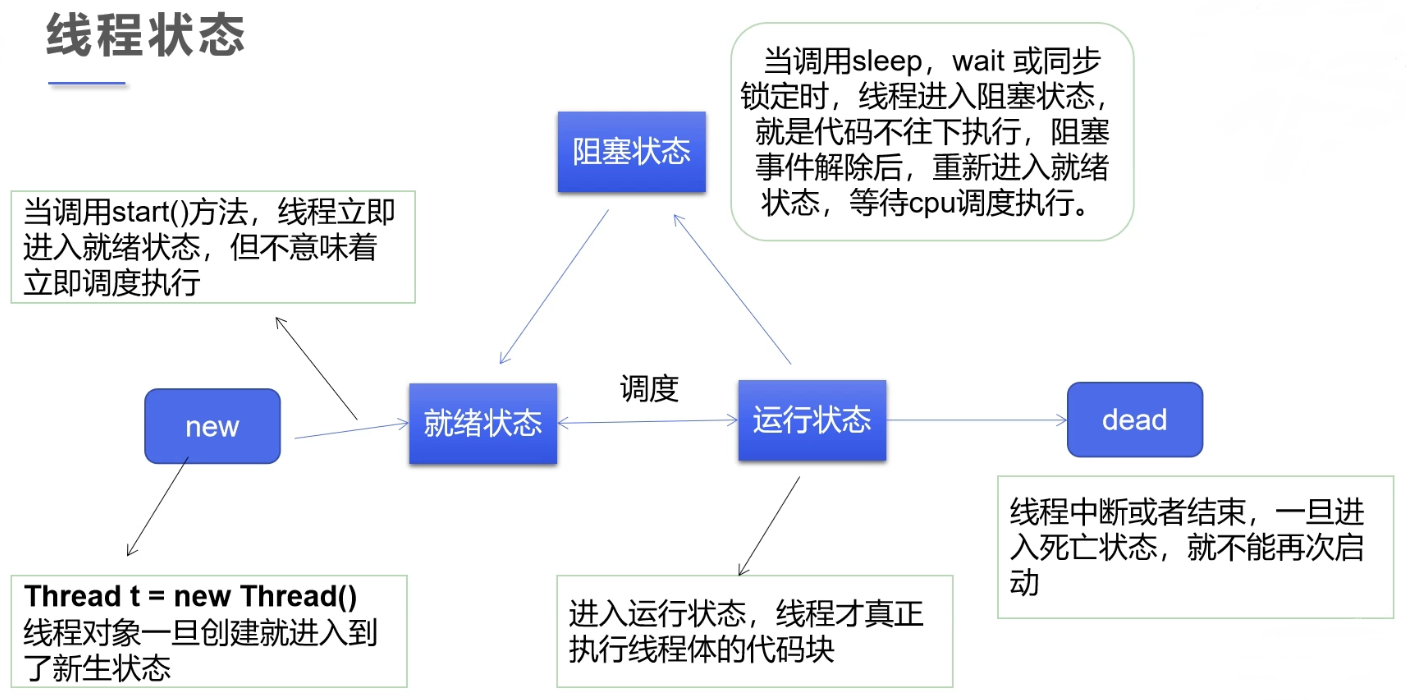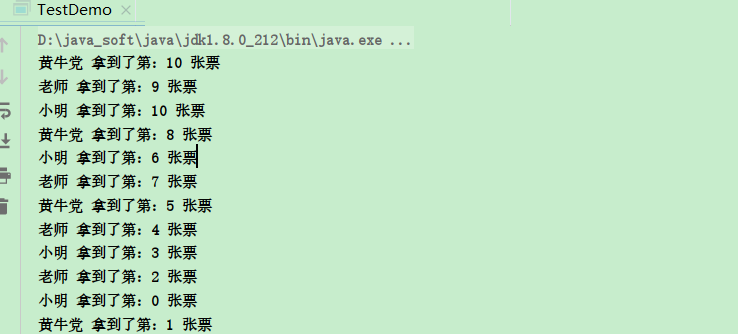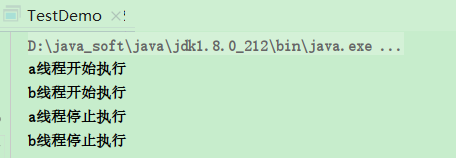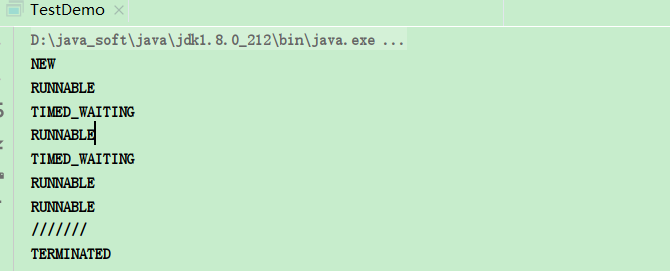线程的定义
一个程序就是一个进程,而一个程序中的多个任务则被称为线程。
进程是表示资源分配的基本单位,线程是进程中执行运算的最小单位,亦是调度运行的基本单位。
1.多线程的所有状态都在Thread中的State枚举中定义,如下所示:
public enum State { /** * Thread state for a thread which has not yet started. */ NEW, /** * Thread state for a runnable thread. A thread in the runnable * state is executing in the Java virtual machine but it may * be waiting for other resources from the operating system * such as processor. */ RUNNABLE, /** * Thread state for a thread blocked waiting for a monitor lock. * A thread in the blocked state is waiting for a monitor lock * to enter a synchronized block/method or * reenter a synchronized block/method after calling * {@link Object#wait() Object.wait}. */ BLOCKED, /** * Thread state for a waiting thread. * A thread is in the waiting state due to calling one of the * following methods: * <ul> * <li>{@link Object#wait() Object.wait} with no timeout</li> * <li>{@link #join() Thread.join} with no timeout</li> * <li>{@link LockSupport#park() LockSupport.park}</li> * </ul> * * <p>A thread in the waiting state is waiting for another thread to * perform a particular action. * * For example, a thread that has called <tt>Object.wait()</tt> * on an object is waiting for another thread to call * <tt>Object.notify()</tt> or <tt>Object.notifyAll()</tt> on * that object. A thread that has called <tt>Thread.join()</tt> * is waiting for a specified thread to terminate. */ WAITING, /** * Thread state for a waiting thread with a specified waiting time. * A thread is in the timed waiting state due to calling one of * the following methods with a specified positive waiting time: * <ul> * <li>{@link #sleep Thread.sleep}</li> * <li>{@link Object#wait(long) Object.wait} with timeout</li> * <li>{@link #join(long) Thread.join} with timeout</li> * <li>{@link LockSupport#parkNanos LockSupport.parkNanos}</li> * <li>{@link LockSupport#parkUntil LockSupport.parkUntil}</li> * </ul> */ TIMED_WAITING, /** * Thread state for a terminated thread. * The thread has completed execution. */ TERMINATED; }
2.绘制一张简单的状态图,观察一下线程的生命周期


3.多线程的几种状态
New状态表示刚刚开始,这种线程还没有开始执行。等到线程的start()方法调用时,才表示线程开始执行。
当线程执行时,处于RUNNABLE状态,表示线程所需的一切资源都已经准备好了。
当线程在执行过程中遇到了synchronized同步块,就会进入BLOCKED阻塞状态。这时线程就会暂停执行,直到获得请求的锁。
WAITING和TIME_WAITING都表示等待状态,它们的区别是WAITING会进入一个无时间限制的等待,TIME_WAITING会进行一个有限的等待。
wait()方法等待的线程在等待notify()方法,而通过join()方法等待的线程则会等待目标线程的终止。
当线程执行完毕后,则进入TERMINATED状态,表示结束。
4.线程常用方法
| 方法 | 说明 |
| setPriority(int newPriority) | 更改线程的优先级 |
| static void sleep(long millis) | 在指定的毫秒数内让当前正在执行的线程休眠 |
| void join() | 等待该线程终止 |
| static void yield() | 暂停当前正在执行的线程对象,并执行其他线程 |
| void stop() | 线程中断,已被弃用,因为它是直接中断,相当于直接给你停电,这种方式太暴力,不安全 |
| void interrupt() | 中断线程,非直接中断,而是将当前线程标志为中断标记,只是一个标记 |
| boolean isAlive() | 测试线程是否处于活动状态 |
5.停止线程:
- 不推荐使用JDK提供的stop()、destroy()方法。【已弃用】
- 推荐线程自己停止下来
- 建议使用一个标志位进行终止变量,当flag=false时,则终止线程运行;换句话说就是一个变量控制是否线程还要继续;当线程需要停止的时候,flag=false;让这个线程正常结束。
public class ThreadSafe extends Thread { public volatile boolean exit = false; public void run() { while (!exit){ //do something } } }
6.线程休眠:
- sleep(时间)指定当前线程阻塞的毫秒数;
- sleep存在异常InterruptedException;
- sleep时间达到后线程进入就绪状态;
- sleep可以模拟网络延时,倒计时等;
- 每个对象都有一个锁,sleep不会释放锁;
线程休眠 实例代码:
/** * desc : 模拟网络延时:方法问题的发生性(多个线程同时操作同一个资源对象时,是线程不安全的) * version: 1.0 */ public class TestDemo implements Runnable { //票数 private int ticketNums = 10; @Override public void run() { while (true) { if (ticketNums <= 0) { break; } //模拟延时 try { Thread.sleep(100); } catch (InterruptedException e) { e.printStackTrace(); } System.out.println(Thread.currentThread().getName() + " 拿到了第:" + ticketNums-- + " 张票"); } } public static void main(String[] args) { TestDemo testSleep = new TestDemo(); new Thread(testSleep, "小明").start(); new Thread(testSleep, "老师").start(); new Thread(testSleep, "黄牛党").start(); } }
运行结果:

出现-1张票,所以多个线程同时操作同一个资源对象,是不安全的。
7.线程礼让:
- 礼让线程,让当前正在执行的线程暂停,但不阻塞
- 将线程从运行状态转为就绪状态
- 让CPU重新调度,礼让不一定成功!看CPU心情
线程礼让 实例代码:
/** * desc : 测试礼让线程 * <p> * 礼让不一定成功,看CPU心情 * version: 1.0 */ public class TestDemo { public static void main(String[] args) { MyYield myYield = new MyYield(); new Thread(myYield, "a").start(); new Thread(myYield, "b").start(); } } class MyYield implements Runnable { @Override public void run() { System.out.println(Thread.currentThread().getName() + "线程开始执行"); Thread.yield();//礼让 System.out.println(Thread.currentThread().getName() + "线程停止执行"); } }
运行结果:


所以礼让,有可能成功,有可能不成功。
8.合并线程:
- Join合并线程,待此线程执行完成后,再执行其他线程,其他线程阻塞。
- 可以想象成插队。
- 会让线程阻塞,尽量少用
线程合并 实例代码:
/** * desc : 测试Join方法,想象成插队,非常霸道 * version: 1.0 */ public class TestDemo implements Runnable { @Override public void run() { for (int i = 0; i < 100; i++) { System.out.println("线程Vip来了" + i); } } public static void main(String[] args) throws InterruptedException { //启动我们的线程 TestDemo testJoin = new TestDemo(); Thread thread = new Thread(testJoin); thread.start(); //主线程 for (int i = 0; i < 1000; i++) { if (i == 200) { thread.join();//插队(这里一插队,就是当主线程执行到i==200的时候,就让子线程去执行打印“线程Vip来了”,必须等插队的那个子线程打印100条“线程Vip”执行完了,再继续执行主线程没有执行完的语句。) } System.out.println("main" + i); } } }
9.线程状态观测:
- Thread.State
线程状态。线程可以处于以下状态之一:
- NEW 尚未启动的线程处于此状态
- RUNNABLE 在Java虚拟机中执行的线程处于此状态
- BLOCKED 被阻塞等待监视器锁定的线程处于此状态
- WAITING 正在等待另一个线程执行特定动作的线程处于此状态
- TIMED_WAITING 正在等待另一个线程执行动作达到指定等待时间的线程处于此状态
- TERMINATED 已退出的线程处于此状态
一个线程可以在给定的时间点处于一个状态。这些状态是不反应任何操作系统线程状态的虚拟机状态。
线程状态观测 实例代码:
/** * desc : 观察测试线程的状态 * version: 1.0 */ public class TestDemo { public static void main(String[] args) throws InterruptedException { Thread thread = new Thread(new Runnable() { @Override public void run() { for (int i = 0; i < 5; i++) { try { Thread.sleep(100); } catch (InterruptedException e) { e.printStackTrace(); } } System.out.println("///////"); } }); //观察状态 Thread.State state = thread.getState(); System.out.println(state);//NEW //观察启动后 thread.start(); state = thread.getState(); System.out.println(state);//Run while (state != Thread.State.TERMINATED) {//只要线程不终止,就一直输出 Thread.sleep(100); state = thread.getState();//更新线程状态 System.out.println(state);//输出状态 } } }
运行结果:

需要注意的是,死亡之后的线程是不能再次启动,否则会报错。
10.线程优先级:
- Java提供一个线程调度器来监控程序中启动后进入就绪状态的所有线程,线程调度器按照优先级决定应该调度哪个线程来执行。
- 线程的优先级用数字表示,范围从1~10.
Thread.MIN_PRIORITY=1;
Thread.MAX_PRIORITY=10;
Thread.NORM_PRIORITY=5;
- 使用一下方式改变或获取优先级
getPriority(); setPriority(int xxx)
线程优先级 实例代码:
/** * desc : 测试线程的优先级 * version: 1.0 */ public class TestDemo extends Thread { public static void main(String[] args) { //主线程 默认优先级 为5 System.out.println(Thread.currentThread().getName() + "--->" + Thread.currentThread().getPriority()); MyPriority myPriority = new MyPriority(); Thread thread1 = new Thread(myPriority); Thread thread2 = new Thread(myPriority); Thread thread3 = new Thread(myPriority); //先设置优先级,再启动,不设置优先级,默认为5 thread1.start(); thread2.setPriority(3); thread2.start(); thread3.setPriority(Thread.MAX_PRIORITY);//MAX_PRIORITY = 10 thread3.start(); } } class MyPriority implements Runnable { @Override public void run() { System.out.println(Thread.currentThread().getName() + "--->" + Thread.currentThread().getPriority()); } }
运行结果:

可以看到,设置优先级,但却不一定说优先级高的就一定能先执行。因为优先级低的线程,只是说它被CPU调度的概率低,并不是说优先级低就不会被调度到,这个决定权还是得看CPU。
11.守护线程(daemon):
- 线程分为用户线程和守护线程
- 虚拟机必须确保用户线程执行完毕
- 虚拟机不用等待守护线程执行完毕
- 如:后台记录操作日志,监控内存,垃圾回收等待..
可以通过setDaemon(true)把线程设置成守护线程, 默认是false,表示用户线程,正常的线程都是用户线程。
守护线程 实例代码:
public class TestDemo { /** * desc : 测试守护线程 * <p> * version: 1.0 */ public static void main(String[] args) { God god = new God(); You you = new You(); Thread thread = new Thread(god); thread.setDaemon(true);//默认是false,表示用户线程,正常的线程都是用户线程 thread.start();//上帝 守护线程启动... new Thread(you).start();//你 用户线程启动... } } //上帝 class God implements Runnable { @Override public void run() { while (true) {//因为虚拟机不用等待守护线程执行完毕,所以这里直接给了一个true条件 System.out.println("上帝保佑着你"); } } } //你 class You implements Runnable { @Override public void run() { for (int i = 0; i < 50; i++) { System.out.println("你一生都开心地或者"); } System.out.println("=======goodbye! world!======");//hello ,world } }
程序只要当用户线程执行完毕后,就会停止,程序不会根据守护线程是否执行完毕,而是根据用户线程,用户线程执行完了,程序也就结束了。